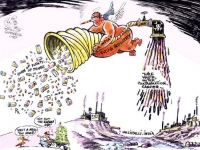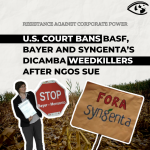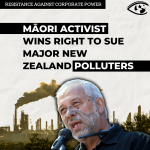Exporting Cures, Importing Misery

Nagamani slaps a wet shirt against a rock. "Oh, no, I only wash clothes in this stream," she says. "If you bathe in it, you get a rash."
She pulls more clothes from her bucket. It's a quiet, peaceful scene, typical of rural India - if you don't get too close to the dark brown stream water with its strange odor, and if you turn your back to the dark plumes rising from a half-dozen smokestacks on the horizon.
Outside his home in the nearby village of Gandigudem, a farmer named Janardhan points to his abandoned plow, his junked rice mill and his idle irrigation well and pump. "Around here, if we have good water we can survive," he says. "Now, without good water, we're finished. If this pump still worked, the water would be coming out of the ground that color." He points to my bright green shirt.
"Look at the trailer I use to haul soil and sand. It's completely rusted out. I bought it new, on ... " He writes the date in the palm of his hand: 26/11/98. "If our soil and water does that to steel in six years, imagine what it's doing to our bodies?" He opens his shirt and points to a rash on his neck and chest. "I walk a few steps, and I'm out of breath. I'm only 39 years old!"
A neighbor, Rekha, says that her subsidized rice ration never lasts till the end of the month. "Before the pollution, we grew our own rice. Now I can't grow crops, four of my water buffalo have died, and we're forced to depend on the government."
Two miles upstream from Gandigudem is the notorious Kazipally industrial area, home to an assortment of chemical and pharmaceutical companies. Behind one factory, identified by a sign as belonging to SMS Pharmaceuticals, tar-like water dribbles over a concrete dam, runs down a deep gully, and meanders through a barren field beyond.
A second sign in front of the plant, erected by court order, lists some of the chemicals being used: toluene, methyl isothiocyanate, DMSO, chloroform. It's nearly impossible to breathe anywhere within a hundred yards of the plant, and it's hard not to retch.
Poisonous History
Kazipally lies in the drainage of the Nakkavagu rivulet, in the state of Andhra Pradesh. This was once good farm country. The watershed, about 10 miles by 25 miles, was crisscrossed by intermittent streams, their water conserved in a chain of 14 small, picturesque reservoirs called cherus that provided irrigation water during the long dry season.
But by the 1970s, the area's good water, wide open spaces and proximity to Hyderabad (India's fifth largest city) made it a prime target for economic development. The first big industrial park was sited near Patancheru, the Nakkavagu basin's only town of any size. Since the late '80s, a half-dozen such estates have cropped up across the surrounding countryside. Over that time, the word "Patancheru" has come to acquire multiple meanings: a lake, a town, a region, and an ecological catastrophe.
In travel books, India is inevitably described as "colorful." The term is certainly apt in this area, but with a nasty twist. Where National Highway 9 crosses the Nakkavagu just west of Patancheru, the sluggish stream is deep purple. In a dump outside the Isnapur industrial estate south of the highway, an alien landscape of grey ash mounds is dotted by clumps of burnt-orange and sulfur-yellow powder. Asanikunta, a lake bordering the Bollaram industrial estate, has the color of cabernet sauvignon and the aroma of paint thinner.
The Patancheru region has fallen into this state through the combined impacts of diverse industries: pesticides, steel, chemicals and others. The destruction of agriculture was largely the result of salts, acids and heavy metals moving from factories into streams, groundwater and soil.
But more and more, the area's biggest problem is drugs - perfectly legal drugs.
Unnatural Disaster
India's domestic pharmaceutical industry supplies its own market of over a billion people, with plenty to spare. Exports have shot up in recent years to $2.5 billion and are predicted to hit $6 billion by 2010. India was the United States' top source of imported antibiotics in 2002. Thirty-five to 40 percent of India's bulk-drug manufacturing now occurs along a 20-mile-long arc from Patancheru to Hyderabad; that's a lot of production, and a lot of waste.
Aurobindo Pharma Ltd., typical of the larger companies operating in the area, makes a wide array of products: antibiotics, anti-HIV drugs, antidepressants, drugs to lower blood pressure, statins to lower cholesterol, cardiovascular drugs, and remedies for acid reflux, athlete's foot and osteoporosis. Some of these products, designed to alleviate diseases of affluence, would hold little interest for most of India's rural population. But the people who live and work in the Nakkavagu basin appear to be far sicker than average, hit with diseases of the rich as well as those of the poor.
Dr. Allani Kishan Rao has practiced medicine and fought pollution in Patancheru for 30 years. He says, "Illness rates here are more than 25 percent, compared with 10 percent nationally. I'm sure it is related to the chemical intermediates, organic solvents, and gases that come out of the pharmaceutical plants and the factories that supply them."
Finished drugs undergo extensive safety testing, but, says Dr. Rao, no one knows what the smorgasbord of molecules currently being released from the drug plants is doing to his patients, especially when combined with pesticides and heavy metals from other factories.
For Westerners who are now feeling powerless in the wake of the Dec. 26 tsunami, Dr. Rao has a message: the West, now directly connected to Patancheru via the global pharmaceutical market, is in a position to help stop a disaster-in-progress.
In October 2004, Greenpeace India released the results of a study comparing the health of almost 9,000 people in nine Nakkavagu-basin villages with a control group of four villages in a non-industrial part of the same district. Cancer rates in the nine affected villages were 11 times as high as in other villages. Rates were 16 times as high for heart disease; four times as high for birth defects; and two to three times as high for skin problems and disorders of the nervous, endocrine and metabolic systems.
Researchers at Hyderabad's Osmania University say privately that preliminary data from their own survey, due to be completed by this fall, do not show such high cancer rates. But Dr. Rao says the Greenpeace results are consistent with his clinical experience: "I am seeing far more cancers, heart ailments, birth defects, and epilepsy than I did in the '70s and early '80s, especially among children. And I'm seeing a lot of tuberculosis, indicating that immune systems are being compromised as well."
Small Change
Officials at Aurobindo Pharma and at Matrix Laboratories (another large pharmaceutical firm, with plants in Kazipally) steadfastly refused to discuss the steps they are taking, if any, to control pollution.
Venkat Ram, who runs Denisco, a small, specialized chemical company in Hyderabad, defends the industry. "I would not like to be in the position of the big corporations that manufacture bulk drugs. They have enormous production runs, as compared with my small volumes, and their waste-disposal costs are correspondingly huge. That's a serious problem in their market, with its cutthroat price competition."
But, says Ram, "The drugmakers I know are very careful to abide by environmental regulations. To survive these days, they have to export into regulated markets, and that means they have to follow strict international standards set by the World Health Organization."
He feels that India's skyrocketing exports can't be blamed for pollution of the Nakkavagu basin; on the contrary, he says, international markets are creating pressure for cleaner, safer manufacturing practices. "It's not like the '80s and '90s when guys were dumping all over the place."
At least superficially, conditions at some of the bigger drug operations don't seem too bad. At Aurobindo Pharma's Unit Number 5 in the Isnapur estate, there's a strip of green grass around the factory perimeter, and the company has planted a mini-forest of eucalyptus, next to a small shantytown across the road. Residents of the huts line up with water pots outside one corner of the factory, where a hose providing safe, trucked-in drinking water has been flung over the wall for their use.
Dr. Rao takes care to note that some improvements have gone beyond the merely cosmetic. Air pollution has been reduced in and around the town of Patancheru, good water is now piped into all area villages whose groundwater has been ruined, and companies are starting to install at least some pollution control systems. But in many cases the more toxic production steps have simply been outsourced.
"Go to the main units of the bigger companies, where they are making finished drugs for export, and it will all look very green," he says. "Just be careful not to go to places like Kazipally and Bollaram, where their intermediates and solvents are being produced."
Since the mid-'90s, all area factories have been legally required to haul their toxic wastes to a Central Effluent Treatment Plant just outside Patancheru, on a tributary of the Nakkavagu. In return for the costs they incur in obeying this law, companies are allowed to wash their hands of legal responsibility for their effluents.
But villagers say that much waste is still dumped in the countryside in the dead of night, and the CETP's capacity is overwhelmed daily by a flood of raw toxic input. Its outflow often carries pollutants at many times the statutory limits.
The treatment plant lies about a mile off Highway 9, on an unusually robust concrete road built to withstand heavy tanker traffic. Here, too, the odors are intolerable. (Spend time in the Patancheru region, and it's easy to become obsessed with smells - and easy to forget about those toxic elements and compounds that are odorless.)
To find the plant's outlet pipe, you have to cross the concrete road and clamber down a ravine. Pouring from the pipe is a stream of coffee-colored effluent topped with thick, white foam. This devil's cappuccino will rejoin untreated toxic effluents in the Nakkavagu, which flows into the Manjira River. The Manjira, in turn, is a tributary of the great Godavari, which waters the highly productive rice lands of the state's coastal plain.
Bhopal in Slow Motion
Back in Gandigudem village, Janardhan looks out over the few acres where he once grew rice. On this day, a group of boys are using the abandoned paddy as a cricket field. A lone water buffalo grazes on some weeds. Asked what becomes of the buffalo's milk, Janardhan says, "We'll sell it on the market, but we sure won't drink it."
Another ruined farmer, Rajaiah, shows me photographs of three water buffalo for which he had paid 20,000 rupees (almost $500) each. The animals, to all appearances well-fed, lie dead in a patch of tall grass where they had collapsed a few months ago. A half-born calf protrudes from one of the cows.
Demand for pharmaceuticals in India and in the West continues its rapid growth, while the toxic tide rises in Andhra Pradesh. Official responsibility for stemming that tide falls to the state's Pollution Control Board. As one of its many tactics in this battle, the Board has established a Night Task Force to crack down on clandestine dumping. But Board members told New Delhi Television in November 2004 that the situation around Patancheru has been out of control for so long that the Night Task Force is concentrating its efforts elsewhere.
Sudden calamities like the Indian Ocean tsunami or Union Carbide's 1984 poison-gas leak in Bhopal generate closely watched casualty counts. No comparable statistics exist for Patancheru's long-running tragedy, but Dr. Rao believes the toll will climb for years to come.
"We're now into a second generation of toxic exposure. We're seeing another Bhopal - but in slow motion."
AMP Section Name:Pharmaceuticals



